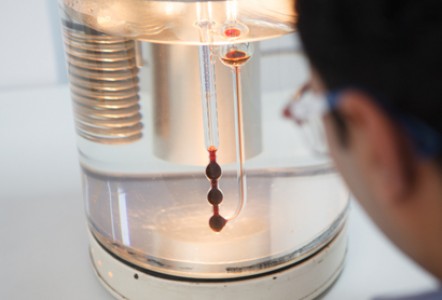Difference Between Volatile and Nonvolatile

A liquid changes into gas following either of two paths; evaporation and vaporization. The basic difference between the two is that evaporation refers to the conversion from a liquid phase to gaseous phase below boiling point, normally at room temperature, whereas in vaporization this conversion mostly takes place at boiling point. Furthermore, evaporation involves conversion from the surface of the liquid, while in the case of vaporization, the evaporation happens with the whole liquid mass. On the basis of the rate of vaporization, substances are divided into two subgroups, volatile and non-volatile substances.
Volatile substances have a very low boiling point and thus have the tendency to vaporize even at room temperature, whereas non-volatile substances have relatively higher boiling points, and do not vaporize at room temperature. The vapor pressure of a substance is the pressure at which its gaseous phase is in equilibrium with the condensed phase, be it solid or liquid. Volatile substances possess a high vapor pressure at room temperature, whereas non-volatile substances do not have a high vapor pressure in normal conditions.
When heated or stored in an open container, the volume of volatile substances decreases quickly, but this does not happen to non-volatile substances; this is because of the higher rate of vaporization of the former. Furthermore, volatile substances are highly inflammable, as compared to non-volatile substances, and catch fire even if brought close to flame, or heated strongly.
All volatile substances have a peculiar smell through which they can be easily detected. Non-volatile substances, on the other hand, are mostly odorless, or have a negligible smell.
Instructions
-
1
Volatile
In chemistry, the term volatile is used to describe substances that have a higher tendency to go into the vaporization phase, even at considerably low temperature. The volatility of a substance is directly related to its vapor pressure, meaning that higher the vapor pressure, the more volatile the substance will be, and vice versa. The term is primarily applied to liquids but it can also be used to describe the process of sublimation in which a solid converts directly into a gas, without undergoing the intermediate liquid phase. Organic compounds, like the compounds of hydrogen and carbon, are more volatile as compared to inorganic compounds.
Image courtesy: calderdaleinrecovery.com
-
2
Non-volatile
Non-volatile substances are those which do not vaporize rapidly. Non-volatile substances possess low vapor pressures, and mostly occur as solids at room temperature. Inorganic substances are mostly non-volatile. Sodium chloride (common salt) and silver nitrate are some common examples of non-volatile compounds.
Image courtesy: sciencedirect.com







